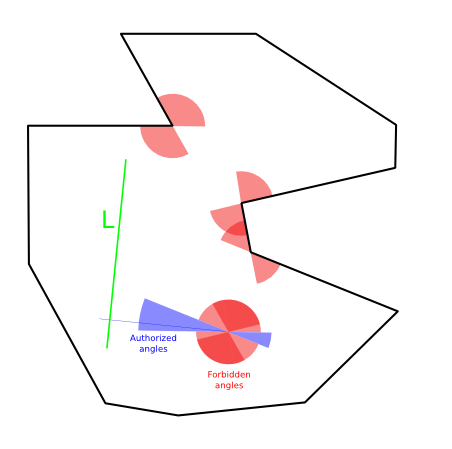It is possible.
Consider you polygon and consider the "concave" vertices. They define exactly which lines will intersect the polygon more than twice. In the following figure I marked the intervals (in red) of forbidden angles. If you put them together and see a hole in the red disk, then there are authorized angles $δ$ (in blue). The polygon is then monotonous with respect to any line of slope $-1/\tan δ$ (in green).

Now the algorithm.
Let $v_i=(x_i, y_i)$ be the $i$th vertex of the polygon. First compute the absolute angle $α_i$ of the edge $(v_iv_{i+1})$ and the inner angle $β_i$ of the vertex $v_i$. Use the function atan2 available in all good programming languages.
$$α_i=\mbox{atan2}(y_{i+1}-y_i,x_{i+1}-x_i)$$
$$β_i = α_{i+1}-α_i+
\left\{
\begin{array}{ll}
0 & \mbox{ if } α_{i+1} ≥ α_i \\
2π & \mbox{ if } α_{i+1} < α_i \\
\end{array}
\right.
$$
Reverse the order of the vertices if they are not in the counterclockwise order, i.e. if $s=\sum_i β_i-nπ$ is not negative. ($s=-2π$: counterclockwise, $s=2π$: clockwise).
The following is only for the $m$ inner angles bigger than $π$ that is, $β_j>π$. The red ones in my pic. The goal is to find an angle $δ$ that is not in $∪_j[α_{j+1},α_j]$ modulo $π$. Namely such that for all $j$ such that $β_j>π$:
$$(δ<α_{j+1} ∨ α_j<δ) \mbox{ if } α_{j+1}<α_j$$
$$(α_j<δ<α_{j+1}) \mbox{ if } α_j<α_{j+1}$$
where $α_j$ is here the normalized value of $α_j$ in $[0,π)$. The second case correspond to an interval that goes beyond $π$ (so this time $δ$ must be "inside").
There is probably a faster way to do this but one in $O(n^2)$ is to sort the values $α_j\mbox{ mod }π $ into $γ_1,…γ_m$ and to test for $δ∈\{\frac{γ_1}2,\frac{γ_1+γ_2}2,…,\frac{γ_{m-1}+γ_m}2,\frac{γ_m+π}2\}$.
If you have find some $δ$ then $L$ exists and is of slope $-1/\tan δ$. Otherwise $P$ is not monotonous.

